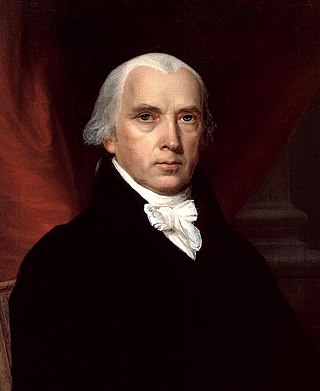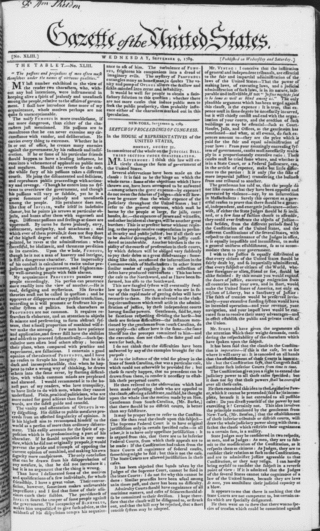Related Research Articles

James Madison was an American statesman, diplomat, and Founding Father who served as the fourth president of the United States from 1809 to 1817. Madison was popularly acclaimed the "Father of the Constitution" for his pivotal role in drafting and promoting the Constitution of the United States and the Bill of Rights.

The Republican Party, retroactively called the Democratic-Republican Party, and also referred to as the Jeffersonian Republican Party among other names, was an American political party founded by Thomas Jefferson and James Madison in the early 1790s that championed liberalism, republicanism, individual liberty, equal rights, decentralization, free markets, free trade, agrarianism, and sympathy with the French Revolution. The party became increasingly dominant after the 1800 elections as the opposing Federalist Party collapsed.

The Federalist Party was a conservative and nationalist American political party and the first political party in the United States. Under Alexander Hamilton, it dominated the national government from 1789 to 1801. Defeated by the Democratic-Republican Party in 1800, it became a minority party while keeping its stronghold in New England and made a brief resurgence by opposing the War of 1812. It then collapsed with its last presidential candidate in 1816. Remnants lasted for a few years afterwards. The party appealed to businesses and to conservatives who favored banks, national over state government, manufacturing, an army and navy, and in world affairs preferred Great Britain and strongly opposed the French Revolution and Napoleonic wars. The party favored centralization, federalism, modernization, industrialization, and protectionism.

The 1792 United States presidential election was the second quadrennial presidential election. It was held from Friday, November 2, to Wednesday, December 5, 1792. Incumbent President George Washington was elected to a second term by a unanimous vote in the electoral college, while John Adams was re-elected as vice president. Washington was essentially unopposed, but Adams faced a competitive re-election against Governor George Clinton of New York.

The 1796 United States presidential election was the third quadrennial presidential election of the United States. It was held from Friday, November 4 to Wednesday, December 7, 1796. It was the first contested American presidential election, the first presidential election in which political parties played a dominant role, and the only presidential election in which a president and vice president were elected from opposing tickets. Incumbent vice president John Adams of the Federalist Party defeated former secretary of state Thomas Jefferson of the Democratic-Republican Party.

The Treaty of Amity, Commerce, and Navigation, Between His Britannic Majesty and the United States of America, commonly known as the Jay Treaty, and also as Jay's Treaty, was a 1794 treaty between the United States and Great Britain that averted war, resolved issues remaining since the Treaty of Paris of 1783, and facilitated ten years of peaceful trade between the United States and Britain in the midst of the French Revolutionary Wars, which began in 1792. The Treaty was designed by Alexander Hamilton and supported by President George Washington. It angered France and bitterly divided Americans. It inflamed the new growth of two opposing parties in every state, the pro-Treaty Federalists and the anti-Treaty Jeffersonian Republicans.

Jeffersonian democracy, named after its advocate Thomas Jefferson, was one of two dominant political outlooks and movements in the United States from the 1790s to the 1820s. The Jeffersonians were deeply committed to American republicanism, which meant opposition to what they considered to be artificial aristocracy, opposition to corruption, and insistence on virtue, with a priority for the "yeoman farmer", "planters", and the "plain folk". They were antagonistic to the aristocratic elitism of merchants, bankers, and manufacturers, distrusted factory workers, and strongly opposed and were on the watch for supporters of the Westminster system.

The history of the United States from 1789 to 1815 was marked by the nascent years of the American Republic.
The tertium quids were various factions of the Jeffersonian Republican Party in the United States from 1804 to 1812.

The values and ideals of republicanism are foundational in the constitution and history of the United States. As the United States constitution prohibits granting titles of nobility, republicanism in this context does not refer to a political movement to abolish such a social class, as it does in countries such as the UK, Australia, and the Netherlands. Instead, it refers to the core values that citizenry in a republic have, or ought to have.

Thomas Jefferson served as the third president of the United States from March 4, 1801, to March 4, 1809. Jefferson assumed the office after defeating incumbent John Adams in the 1800 presidential election. The election was a political realignment in which the Democratic-Republican Party swept the Federalist Party out of power, ushering in a generation of Jeffersonian Republican dominance in American politics. After serving two terms, Jefferson was succeeded by Secretary of State James Madison, also of the Democratic-Republican Party.

The First Party System was the political party system in the United States between roughly 1792 and 1824. It featured two national parties competing for control of the presidency, Congress, and the states: the Federalist Party, created largely by Alexander Hamilton, and the rival Jeffersonian Democratic-Republican Party, formed by Thomas Jefferson and James Madison, usually called at the time the Republican Party.
The Compromise of 1790 was a compromise among Alexander Hamilton, Thomas Jefferson, and James Madison, where Hamilton won the decision for the national government to take over and pay the state debts, and Jefferson and Madison obtained the national capital, called the District of Columbia, for the South. This agreement resolved the deadlock in Congress. Southerners had been blocking the assumption of state debts by the Department of the Treasury, thereby destroying the Hamiltonian program for building a fiscally strong federal government. Northerners rejected the proposal, much desired by Southerners, to locate the permanent national capital on the Virginia–Maryland border.

The National Gazette was a Democratic-Republican partisan newspaper that was first published on October 31, 1791. It was edited and published semiweekly by poet and printer Philip Freneau until October 23, 1793.

The presidency of George Washington began on April 30, 1789, when Washington was inaugurated as the first president of the United States, and ended on March 4, 1797. Washington took office after the 1788–1789 presidential election, the nation's first quadrennial presidential election, in which he was elected unanimously by the Electoral College. Washington was re-elected unanimously in the 1792 presidential election and chose to retire after two terms. He was succeeded by his vice president, John Adams of the Federalist Party.

The Gazette of the United States was an early American newspaper, first issued semiweekly in New York on April 15, 1789, but moving the next year to Philadelphia when the nation's capital moved there the next year. It was friendly to the Federalist Party. Its founder, John Fenno, intended it to unify the country under its new government. As the leading Federalist newspaper of its time, it praised the Washington and Adams administrations and their policies. Its Federalist sponsors, chiefly Alexander Hamilton, granted it substantial funding; because some of it was directly from the government, the Gazette is considered to have been semi-official. The influence of the newspaper inspired the creation of the National Gazette and the Philadelphia Aurora, rival newspapers for the Democratic-Republicans.

The Federalist Era in American history ran from 1788 to 1800, a time when the Federalist Party and its predecessors were dominant in American politics. During this period, Federalists generally controlled Congress and enjoyed the support of President George Washington and President John Adams. The era saw the creation of a new, stronger federal government under the United States Constitution, a deepening of support for nationalism, and diminished fears of tyranny by a central government. The era began with the ratification of the United States Constitution and ended with the Democratic-Republican Party's victory in the 1800 elections.

The United States elections of 1788–1789 were the first federal elections in the United States following the ratification of the United States Constitution in 1788. In the elections, George Washington was elected as the first president and the members of the 1st United States Congress were selected.

Political eras of the United States refer to a model of American politics used in history and political science to periodize the political party system existing in the United States.

Tariff of 1791 or Excise Whiskey Tax of 1791 was a United States statute establishing a taxation policy to further reduce Colonial America public debt as assumed by the residuals of American Revolution. The Act of Congress imposed duties or tariffs on domestic and imported distilled spirits generating government revenue while fortifying the Federalist Era.
References
- ↑ Ohio History Connection. "Democratic-Republican Party". Ohio History Central . Retrieved August 30, 2017.
Democratic-Republicans favored keeping the U.S. economy based on agriculture and said that the U.S. should serve as the agricultural provider for the rest of the world [...]. Economically, the Democratic-Republicans wanted to remain a predominantly agricultural nation, ... .
- ↑ Beasley, James R. (1972). "Emerging Republicanism and the Standing Order: The Appropriation Act Controversy in Connecticut, 1793 to 1795". The William and Mary Quarterly. 29 (4): 604. doi:10.2307/1917394. JSTOR 1917394.
- ↑ Adams, Ian (2001). Political Ideology Today (reprinted, revised ed.). Manchester: Manchester University Press. p. 32. ISBN 9780719060205.
Ideologically, all US parties are liberal and always have been. Essentially they espouse classical liberalism, that is a form of democratized Whig constitutionalism plus the free market. The point of difference comes with the influence of social liberalism.
- 1 2 Larson, Edward J. (2007). A Magnificent Catastrophe: The Tumultuous Election of 1800, America's First Presidential Campaign. Simon and Schuster. p. 21. ISBN 9780743293174.
The divisions between Adams and Jefferson were exasperated by the more extreme views expressed by some of their partisans, particularly the High Federalists led by Hamilton on what was becoming known as the political right, and the democratic wing of the Republican Party on the left, associated with New York Governor George Clinton and Pennsylvania legislator Albert Gallatin, among others.
- ↑ Wood, The American Revolution, p. 100
- ↑ "Democratic-Republican Party". Encyclopædia Britannica . July 20, 1998. Retrieved August 30, 2017.
The Republicans contended that the Federalists harboured aristocratic attitudes and that their policies placed too much power in the central government and tended to benefit the affluent at the expense of the common man.
- ↑ Ornstein, Allan (9 March 2007). Class Counts: Education, Inequality, and the Shrinking Middle Class. Rowman & Littlefield Publishers. pp. 56–58. ISBN 9780742573727.
- 1 2 Wood, Gordon S. (2009). Empire of Liberty: A History of the Early Republic, 1789-1815 . New York: Oxford University Press. p. 140. ISBN 978-0-19-503914-6.
- 1 2 Wood. p. 141.
- ↑ Wood. p. 141–142.
- ↑ Chernow, Ron (2010). Washington: A Life . New York: Penguin Press. p. 631. ISBN 978-1-59420-266-7. LCCN 2010019154.
- ↑ Risjord, Norman K. (2010). Jefferson's America, 1760-1815. Rowman & Littlefield. pp. 267–68. ISBN 9780742561243.
- ↑ Wood. p. 145.
- ↑ Chambers, William Nisbet, ed. (1972). The First Party System.